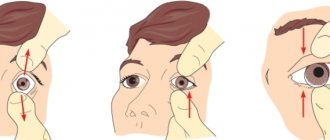If you have watched various Hollywood zombie films, then you have probably seen the incredible eyes of the actors. Achieving this effect is quite simple and requires scleral lenses.
Types of scleral lenses
The first scleral lenses appeared in ophthalmology for the treatment of ophthalmic diseases, but over time they began to acquire another field of application.
History of appearance
The first lenses of this type appeared at the end of the last century. They were made from polymers that are capable of excellent oxygen permeability. Initially, such lenses were used to get rid of increased sensitivity of the cornea. If you compare these lenses with regular ones, then you can understand that their diameter will be almost twice as large. Usually it is 2.2 cm.
The properties of scleral lenses are considered medical, but Hollywood stars have managed to adapt them to suit themselves.
It is important to know! Many actors who are forced to wear such lenses do not like it. Since vision may deteriorate and after a certain time the eyes will get tired.
Many years have passed since their appearance, but now US authorities have begun to believe that their sale is considered illegal. Of course, the authorities think so, but if you are planning to purchase these goods, then you can deal with a similar problem in foreign stores. Many medical experts also report that wearing them will be harmful as frequent wearing may cause vision problems.
Sclera on zombies from the movie
Advantages and disadvantages
Scleral lenses are effective in vision correction. Such optics are indispensable for simulating healthy eyes, hiding ophthalmological defects, increasing the volume in case of an underdeveloped eyeball or drooping eyelid, centering the artificial pupil in the right place in case of strabismus. Decorative lenses provide an unsurpassed cosmetic effect. Due to the rigidity of the material, long-term use of optics is ensured, but experts do not recommend wearing lenses for more than 3 months after opening the package.
One of the main disadvantages is the high cost and long production period of contact means. You can wear them for no more than 3-4 hours without a break, so it is better to put on the optics when necessary. Scleral lenses distort vision, which is why ophthalmologists prohibit wearing them while driving a vehicle. Compared to conventional optics, such lenses require careful individual selection.
Medical use
Today, polymers are no longer used to make such lenses. Now for their manufacture they use a material called PPMA. This material can be considered quite elastic, and it can perfectly follow the shape of your eye. The only drawback of this material is that it will not allow moisture to pass through. That is why you need to be careful while wearing them.
From a medical point of view, these lenses can be used for:
- Treatment of strabismus.
- Treatment of congenital eye defects.
- Treatment of keratoconus.
- With sufficiently high sensitivity of the cornea.
Keratoconus is a disease that is treated with scleral lenses.
Therapeutic scleral lenses may differ from theatrical ones. The main difference is that they will be made of material that will allow moisture to pass through. The space that will be located between the polymer and the eye must subsequently be filled with a special liquid, which helps protect the sclera from increased irritability. In specialized stores you can also find luminous lenses.
Application
Their main purpose is to correct vision and treat eye diseases such as keratoconus, that is, deformation of the cornea of the eye. If we talk about decorative purposes, we can cite as an example their use in filming, when the hero needs to create a shocking or shocking image. Is it possible to wear colored lenses if you have astigmatism? Find out here.
Medical reusable contact lenses for the treatment of keratoconus and vision correction
For patients with poor vision, scleral lenses are an excellent solution for vision correction. In addition, these optical products are recommended for use for a number of eye diseases. Recommended to wear:
- For keratoconus or pellucid marginal degeneration. This pathology is associated with elongation of the cornea, in which it becomes more elongated and significantly exceeds the norm.
- For corneal ectasia, a complication associated with LASIK surgery. The cornea begins to change its shape and thin out against the background of progressive myopia.
- For microphthalmia, a congenital pathology associated with the size of the eye. In such patients it is slightly less than normal, so they are advised to wear it to replenish the missing ocular volume.
- With “dry eye” syndrome, when the ability to reproduce the natural eye fluid, that is, tears, is lost.
- With Stevens-Johnson syndrome - the death of epidermal cells and their separation from the dermis. There is fibrosis of the cornea, the appearance of blisters on the mucous membrane. The syndrome is considered a severe form of epidermal necrolysis of toxic properties.
- With neurotrophic keratitis - inflammation of the cornea due to damage to the ternary nerve.
- For injuries of various types, burns of a chemical and thermal nature, and pathologies of the optical system of the eye organs.
- After cornea transplant surgeries and during complications associated with laser surgeries to improve vision.
Use for decorative purposes
Even seasoned aesthetes and exotic lovers today are surprised by the variety of fashionable optical trends. Using scleral lenses, you can change your appearance beyond recognition, making the whites of your eyes appear in a variety of shades.
Types of lens colors
At carnivals, horror-themed parties, in the film industry and even in everyday life, colored and black people are actively used. For lovers of “horror stories” and the “fantasy” style, specialized stores offer a wide range of multi-colored shades. Are colored lenses harmful? It is described in the link.
Black, red, white all over the eye
We see black, white, red, colored lenses for the entire eye on actors in such famous TV series as: “The Vampire Diaries”, “Supernatural”. Transformation into demonic creatures, vampire werewolves occurs with complete accuracy of getting into the image.
Tokyo Ghoul, crazy lenses, sharingan, rinnegan
These are colored, combining several color shades at once. Thanks to them, a stunning effect is achieved, while there is not the slightest harm to health for the wearer of the optical product.
Green, blue, yellow
Green, blue, yellow are very popular today among people of any age. You can order the product in online stores or purchase it in centers selling goods for carnivals. You can learn about yellow contact lenses in this material.
How to choose scleral lenses?
If you choose lenses that are made of gas permeable material, then remember that they are essentially made from heat-resistant plastic. It will be ground on a special machine and thanks to this the lens can be given the appropriate shape. Then the adjustment will take place thanks to special equipment. That is why the production of scleral lenses takes quite a long time. When selecting these lenses, you should follow the following recommendations:
- Take exact measurements.
- Try on a trial transparent model.
- Now, over the course of several days, the eye will become accustomed to these lenses.
- The final fitting is considered the finishing touch. At this stage, marking of the front part will also occur.
- Now all the elements of a healthy eye will be transferred to plastic.
- After completing the previous stage, you can return home with a new eye.
Girl in black lenses over the whole eye
Alternative optical correction options
There is a Piggyback vision correction method, in which it is necessary to wear two lenses at once - a soft optical product is in direct contact with the cornea, and a hard lens is placed on top of it to create the correct spherical shape.
A similar option is hybrid lenses that combine the characteristics of soft and hard. The edges of hybrid models that come into contact with the eye are made of a soft polymer material, and the center is made of a hard one.
In our country, these methods of vision correction for keratoconus are almost never used, but are widespread in foreign ophthalmological practice.
Note!
Many experts do not recommend purchasing Haptic lenses products. This is due to the fact that not a single seller who sells white scleral lenses will be able to correctly select the safest product for your eyes. Even if you manage to choose a high-quality model, then remember that you will need to use it only under the supervision of an ophthalmologist. If you feel irritation or see redness, then you should immediately contact a specialist for examination.
How to put on scleral lenses?
If you wish to wear scleral lenses, then remember that in this case you will need to follow the following recommendations:
- The main thing is sterility. Before putting it on, your hands will need to be washed with bacterial soap and dried with a dry towel.
Correct placement of black lenses
- The haptic lense must be pulled out of the container and inserted into the eyes with two fingers. The eyelids will first need to be pulled back by hand.
- If the product is in place, then you have completed the task.
To learn more about the technology of putting on scleral lenses, you can watch the video below. If you are interested, then read about mirror lenses.
Withdrawal procedure
To remove these lenses you will need to follow the following procedure:
- Move the lenses down so that their edge stops contacting the cornea.
- You can now pry up the bottom edge and remove the lenses.
It is important to know! When removing scleral lenses, remember not to use additional devices to catch them.
Age is not a hindrance
In order for these products to last for a long time and not cause ophthalmological diseases, they do not need:
- Sleep.
- Shower or swim.
- Stay in dusty rooms.
What contact correction means are most effective for cone-shaped corneas?
In our country, people with keratoconus are most often prescribed rigid gas permeable lenses. Their main advantage is their design features. Due to its rigidity, it corrects the incorrect optics of the cornea, creating the necessary spherical shape of the anterior surface of the eye. As a result, the light is focused on the retina, so the person sees a clear image. Models of this type are permeable to oxygen, so the eyes “breathe” in them and remain healthy. Hard lenses are easy to care for and easy to wash, remove and put on. Typically, optical products are made to order and take into account the shape of a particular person's cornea.
Soft optical products are used less frequently for keratoconus. Due to their elasticity and softness, they take the shape of the eye, whereas in the case of keratoconus it is necessary to correct this shape. Soft models are prescribed for those whose disease is of low severity.
Scleral models are a type of rigid lens. Their peculiarity is that they have a large diameter (up to 26 mm), due to which the support of the lens is the sclera, and not the cornea. Wearing such lenses reduces the load on the affected cornea and is considered the best option for keratoconus. There are also semi-scleral models (diameter about 16 mm), in which the support is distributed between the cornea and sclera.
Photos of scleral lenses
If you cannot decide on the type of these lenses, then you can look at the photos that we have placed below.
Fire sclera
Original black sclera
Bright green scleral lens
Interesting sclera
Scleral lenses with teeth painted on them
This is our list of original scleral lenses. We hope you liked our information.
Wear contact lenses correctly
It is best to start the procedure in a well-lit bathroom or near a window, sitting in front of a mirror.
1. Wash your hands thoroughly with soap. If for some reason this is not possible, use an antibacterial solution or special disinfectant wipes. 2. Open the container or blister if you are using daily lenses. If lenses have different diopters, it is important not to confuse the left and right. 3. Use special tweezers with soft silicone tips on the ends to remove optical products.
Important!
Do not use your fingers to remove contact lenses, especially if you have long nails. You can damage the lens itself, and subsequently cause microtrauma to the tissues of the eye.
4. After you have taken the lens out of the container, place it on the pad of the index or middle finger of the hand with which you are most comfortable performing manipulations. 5. Check the correct position of the lens: a correctly positioned lens looks like a bowl - with the correct shape of a hemisphere, the edges of which are directed upward. A lens turned inside out resembles a saucer, the edges of which are directed to the sides. But even if you accidentally put on an inverted lens, nothing bad will happen - such a lens simply will not stay on the cornea, and with every blink it will slide off, causing discomfort, and will not damage your eyes. , but she will definitely need to be changed.
Important!
Before putting on your lenses, inspect them for foreign particles such as small particles, towel lint, or animal hair. And also check for microdamage to the products - cracks, creases and scratches will not only cause discomfort, but also cause injury.
6. With your free hand, spread the upper and lower eyelids, look straight or upward. Bring the contact lens to your eye - just below the pupil, do not focus your gaze on it. As soon as you touch the sclera with the lens, you can slowly close your eyelids - in this case, the pupil will reflexively move down, and the lens will be placed on it. 7. To ensure that the lens finally takes the correct position, you can lightly massage your closed eyes or blink. 8. Repeat the same procedure with the other eye.









